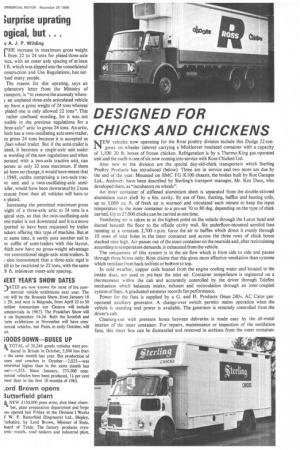DESIGNED FOR CHICKS AND CHICKENS
Page 43

If you've noticed an error in this article please click here to report it so we can fix it.
MEW vehicles now operating for the Ross poultry division include this Dodge 22-tongross six-wheeler (above) carrying a Ivlickleover insulated container with a capacity of 1,100 20 lb. boxes of frozen chicken. Refrigeration is by a Thermo-King gas-operated unit and the outfit is one of six now coming into service with Ross Chicken Ltd. Also new to the division are the special day-old-chick transporters which Sterling Poultry Products has introduced (below). Three are in service and two more are due by the end of the year. Mounted on BMC FO 1(100 chassis, the bodies built by Roe Garages Ltd., Andover, have been described by Sterling's transport manager, Mr. Ken Dace, who developed them, as "incubators on wheels".
An inner container of stiffened aluminium sheet is separated from the double-skinned aluminium outer shell by a 6in. cavity. By use of fans, ducting, baffles and heating coils, up to 3,000 Cu. ft. of fresh air is warmed and circulated each minute to keep the input temperature to the inner container to a pre-set 70 to 80 deg. depending on the type of chick carried. Up to 27,000 chicks can be carried at one time. Ventilating air is taken in at the highest point on the vehicle through the Luton head and ducted beneath the floor to the offside cavity wall. Six underfloor-mounted aerofoil fans running at a constant 2,700 r.p.m. force the air to baffles which direct it evenly through 10 rows of inlet holes in the inner container and across the three rows of chick boxes stacked nine high. Air passes out of the inner container on the nearside and, after recirculating according to temperature demands, is exhausted from the vehicle. The uniqueness of this system is in the air flow which is from side to side and passes through three boxes only; Ross claims that this gives more effective ventilation than systems which ventilate from back to fiont or bottom to top. In cold weather, copper coils heated from the engine cooling water and located in the intake duct, are used to pre-heat the inlet air. Container temperhture is registered on a thermometer within the cab and accurately controlled by the driver through Teleflex mechanism which balances intake, exhaust and recirculation through an inter-coupled system of flaps. A graduated ammeter records fan performance.
Power for the fans is supplied by a G. and H. Products Onan 240v. AC Calor gasoperated auxiliary generator. A change-over switch permits mains operation when the vehicle is standing and power is available. The generator is remotely controlled from the driver's cab.
Cleaning-out with pressure hoses between deliveries is made easy by the all-metal interior of the inner container. For repairs, maintenance or inspection of the ventilation fans, this inner box can be dismantled and removed in sections from the outer container.












































































































